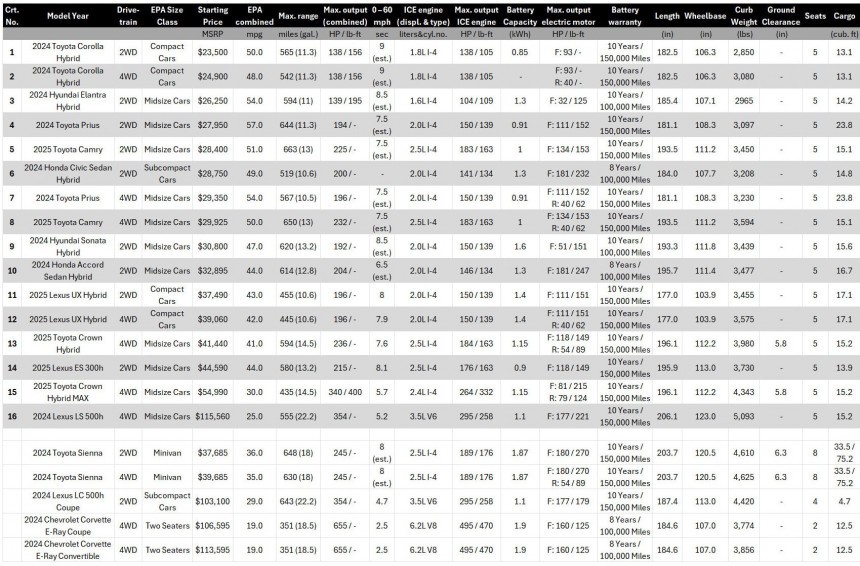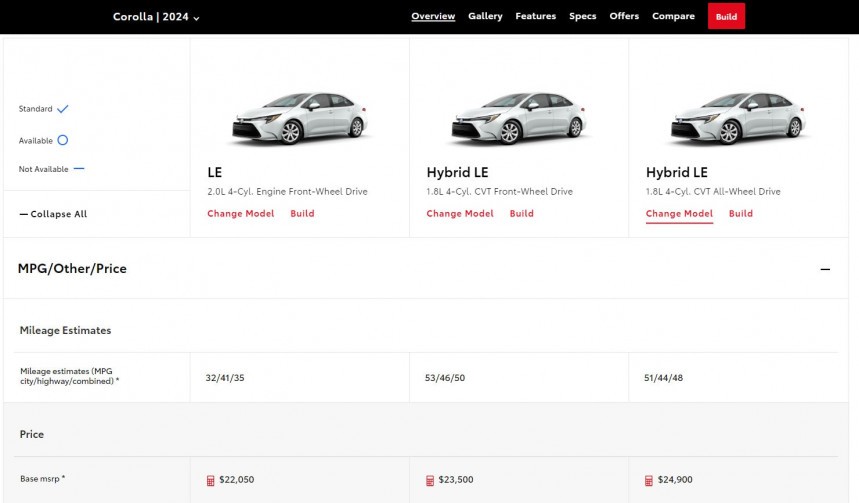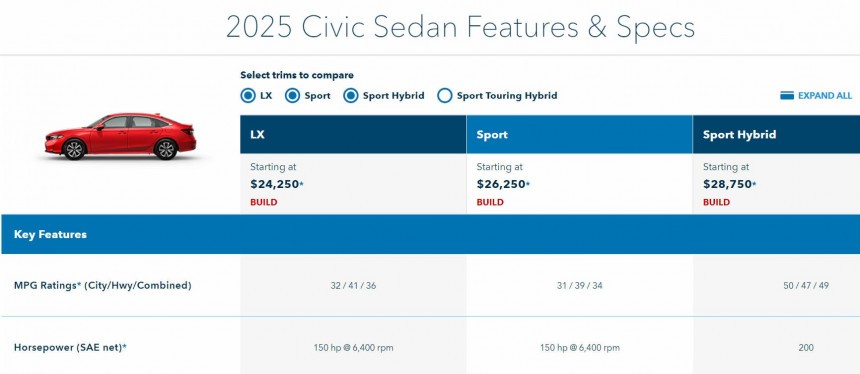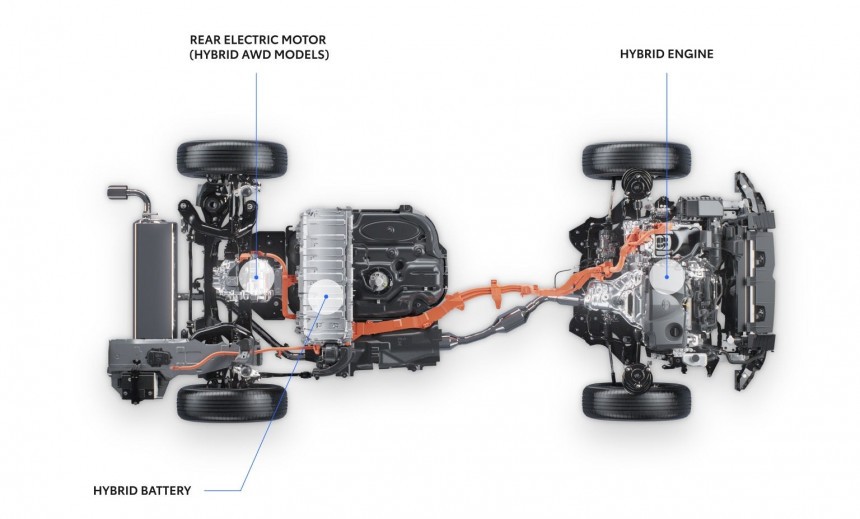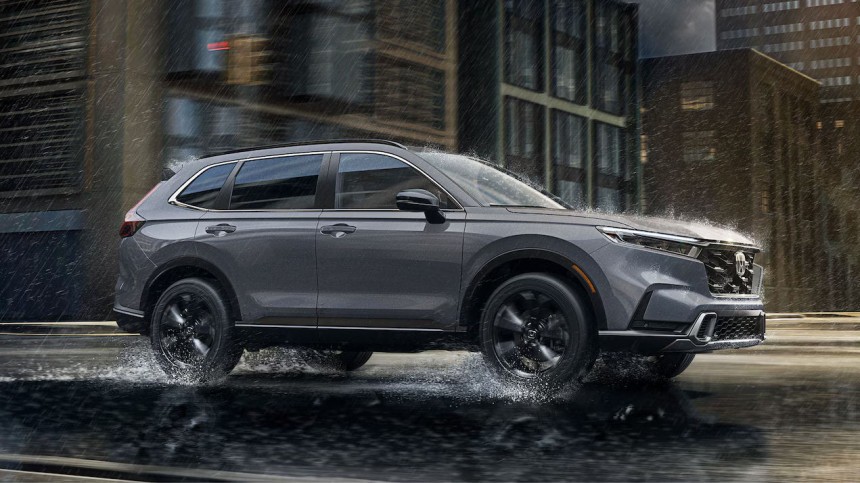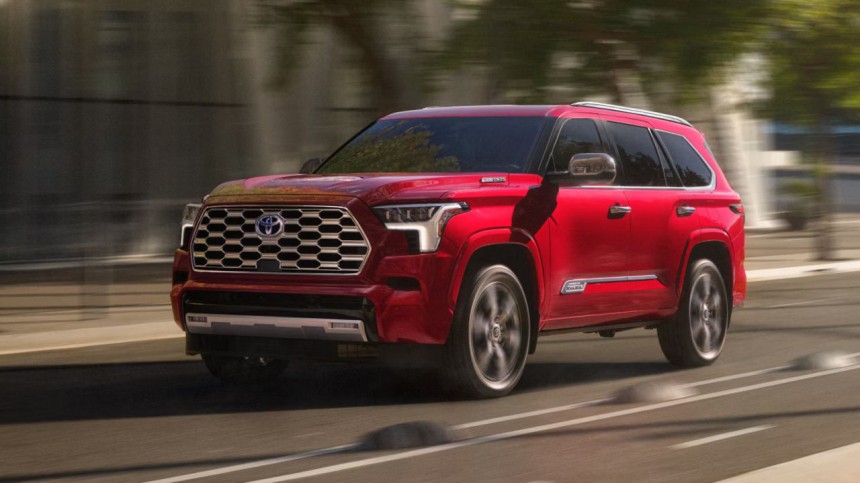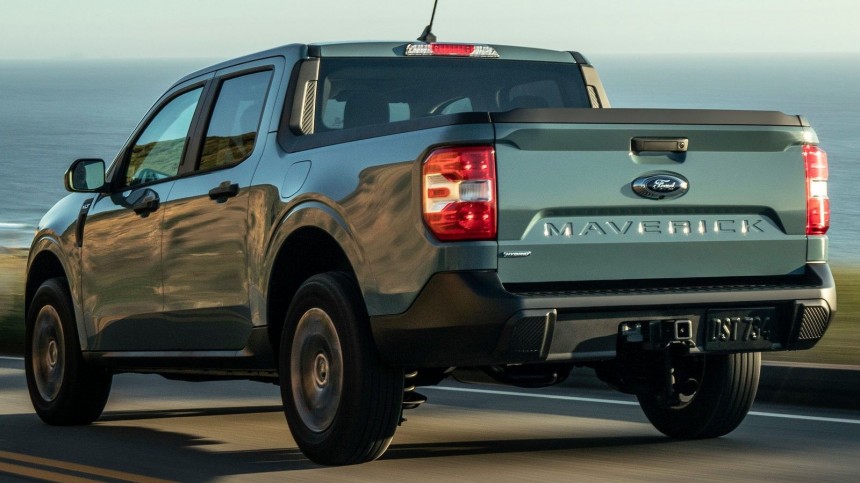Last time, I told you that almost 60 models and variants currently use full hybrid systems, as opposed to the EPA's list of around 200, most of which are mild-hybrid vehicles. To simplify things, now I divided the list into two categories: hybrid cars and hybrid SUVs and trucks.
You probably saw in the previous part of this article that more than half the list is comprised of Toyota hybrid powertrains. You shouldn't be surprised; for over two and a half decades, the Japanese sold around 40 million hybrid Toyotas and Lexuses. It's no wonder that today, Toyota is at the top of everyone's mind for anyone looking for a hybrid car.
For instance, the entry-level ICE Toyota Corolla starts at $22,050, while the entry-level hybrid variant with the same trim costs $23,500. The difference is less than $1,500, and the hybrid's combined EPA consumption is much better: 50 mpg vs. 35 mpg.
At $3.5 per gallon, you save three bucks every 100 miles, and the Corolla hybrid breaks even in less than 50,000 miles. According to the Federal Highway Administration, American drivers average 15,000 miles/year, so the hybrid becomes less costly after 3 years.
How about the Hyundai Elantra Hybrid, which is even more efficient than Corolla? Well, things don't look good at first. The most affordable Elantra Hybrid takes around 140,000 miles to break even compared to the most affordable gasoline Elantra.
However, the hybrid's Blue trim must be compared to the gasoline's next-level trim, the SEL. This time, the hybrid breaks even in 70,000 miles, similar to the top-of-the-line Limited trim.
The same observation regarding comparable trims is also valid for the Honda Civic. The entry-level gasoline LX trim starts from $24,250, while the entry-level hybrid Sport starts from $28,750 ($4,500 more). This way, the hybrid breaks even in about 170,000 miles.
If we compare the gasoline Sport trim (starting from $26,250) to the similar trim on the hybrid, the latter breaks even in less than 80,000 miles. For more expensive cars, like the Hyundai Sonata or Honda Accord (starting at more than $30,000), the break-even mileage is between 70,000 and 100,000 miles.
So, if you need a relatively affordable (but not the cheapest around) car for heavy usage, a hybrid vehicle is already a very solid option instead of an ICE one. Also, remember that the break-even mileage is expected to be even better because gasoline cars tend to consume much more in real life. At the same time, hybrids are much more efficient, especially in city dwellings.
Thanks to a second electric motor mounted on the rear, you can have a $25,000 all-wheel drive, low-consumption compact car like the Corolla or a less than $30,000 AWD hybrid like the Prius or Camry. It will cost you some grand and a half extra, a couple of mpg less to your fuel consumption, and around a hundred lbs. more to curb weight.
In return, you'll get a safer and even nimbler car because an electric AWD system has a better response than a classic AWD system, which sends the power to the wheels in the back through a high-inertia shaft and some complicated clutches. Oh, and don't forget that the second electric motor adds power and torque.
I remember that every time I tested an AWD car fitted with such an electric AWD system, it just felt better. No wonder Chevrolet decided to add a front electric motor to the RWD Corvette, thus making the Corvette E-Ray even quicker than the Corvette Z06. Mind you, the E-Ray has a proper hybrid system, as opposed to 911 GTS's new T-Hybrid system, which is more of a mild hybrid one.
Of course, most people opt for an AWD system when buying an SUV or a truck, so it's time to take a look at the second table:
It seems like a fairly long list, I know, but actually, there are only 20 model names there – half of the model names on the list of fully electric SUVs available on the US market today. You draw your own conclusion based on this piece of information.
Meanwhile, I will notice that only one small SUV, the KIA Niro (also the most affordable on this list), doesn't have an AWD variant. Almost all others have both 2WD and 4WD variants, while some don't even bother giving you the option for a 2WD variant.
The SUVs on this list generally have a classic electro-mechanical AWD system, but about a third opted for mounting that extra electric motor on the rear axle. Unsurprisingly, they are all from Toyota and Lexus. The Japanese have a serious edge.
For instance, thanks to the second electric motor on the rear axle, the Toyota RAV4 Hybrid AWD gets better or the same mileage as AWD competitors KIA Sportage, Hyundai Tucson, Honda CR-V, or Ford Escape. The RAV4 is also the second most affordable from this pack, so here's your answer to its sales success in the US.
I believe this trend will spread to new hybrid SUV models because it is more efficient. The fact that almost all electric SUVs over $40,000 have electric AWD is a hint. Meanwhile, RAV4's competitors charge $1,500-1,800 for the classic AWD system, with a toll on consumption of up to 5 mpg.
However, just like in the case of hybrid cars, the real question is this: Is a hybrid SUV a better deal than its gasoline counterpart? Let's find out.
Well, then, how does the CR-V Hybrid compare to its gasoline sibling? The most affordable gasoline variant is the LX trim, starting at $30,100, while the most affordable hybrid variant is the Sport trim, starting at $34,350. In this flawed comparison, the hybrid breaks even in about 140,000 miles.
The hybrid's Sport trim is very close in terms of equipment to gasoline's EX trim, starting from $32,350 (two grands less than the hybrid): this time, the hybrid breaks even in less than 70,000 miles, similar to Civic's case.
Things are a little tricky with the Toyota RAV4 Hybrid because it's only AWD, while the gasoline version is offered in both 2WD and AWD. Thus, the hybrid breaks even in around 100,000 miles compared to the 2WD gasoline and in 60,000 miles compared to the AWD gasoline.
How about the most affordable hybrid small SUV, the KIA Niro? Well, it doesn't have a classic gasoline variant, so we could compare it to its Soul "cousin," which ditched the electric version in the US and is a gasoline-only crossover. It is very close to Niro regarding specs and equipment but a bit smaller.
The entry-level Niro hybrid breaks even in around 133,000 miles compared to the most affordable gasoline Niro, while the EX trim (top-of-the-line for Niro) will give you a lower break-even value of around 100,000 miles. Of course, it's not a valid comparison, but it's a good exercise highlighting the big gains of the hybrid powertrain: you'll save $5 every 100 miles with the Niro hybrid!
The real challenge for KIA Sportage is that the FWD entry-level hybrid will break even in just 32,000 miles, while the AWD will take even less (29,000 miles) thanks to a smaller decrease in efficiency than the gasoline variant. As for the bigger Sorento, the 2WD hybrid EX trim breaks even in less than 13,000 miles compared to the 2WD gasoline EX trim.
Moving up the scale to bigger and heavier SUVs, hybrid's advantages become clearer, as bigger weight affects much more of a classic gasoline engine's efficiency and fuel consumption. For instance, the Toyota Grand Highlander Hybrid (the AWD weighs over 4,500 lbs) needs around 34,000 miles to break even compared to the similar AWD trim of its gasoline counterpart.
It's one reason the Sequoia heavy-weight SUV (the 4WD passes the 6,000 lbs bar) is offered solely in a hybrid version. In the meantime, the most powerful powertrain for its sibling Tundra pickup truck is the i-Force Max hybrid, with a total output of 437 hp and a torque of 583 lb.-ft. – a big step over the gasoline V6 of "only” 389 hp and 479 lb.-ft.
However, there's still a big "if" for the hybrid powertrain becoming more popular in the pickup truck realm. The payload and towing capacity are more important than dynamics or fuel savings for this kind of vehicle.
Due to the reliability requirements in harsh conditions, adding an electric motor on the rear axle is not feasible, so hybridization is constrained under the hood for now. Of course, a small pickup truck like the Ford Maverick, in the front-wheel drive setup, is more prone to a small SUV job than a heavy-duty workhorse.
I can't figure out why anyone would want a gasoline Maverick when the hybrid only needs around 37,000 miles to break even. This is a better break-even value than the Toyota Corolla hybrid! Too bad the Maverick Hybrid doesn't come in an AWD flavor. It would surely be among the best deals for a full hybrid vehicle.
This summarizes popular wisdom's preference for hybrids, all the more so because the car industry contributes largely to misleading customers by suggesting that mild hybrid systems are similar to full hybrid ones, which is not the case. The same applies to considering plug-in hybrids as a better alternative to EVs for those frightened by range anxiety.
In short, a full-hybrid car makes sense only if it costs you less in the long run, and its efficiency proves better compared to a regular ICE similar car. There's no such thing as comparing a hybrid powertrain to a battery-electric one – even if it's a plug-in, the hybrid remains an ICE-based solution.
So, please do not fall into the trap of thinking you're just less green if you drive a hybrid car instead of a proper electric one. The truth is the other way around: you're just a little less polluting with a hybrid than with an ICE car.
But hey, if you're fine with far-from-zero emissions, at least you have a number of full hybrid options out there, and most of them will probably suit you better than comparable gasoline variants. Let me know if you ditch your ICE car for a proper hybrid.
Hybrid cars: more pros than cons
The first thing that struck me was that almost all of the cars in this list's TOP 10 have an MSRP starting price of less than $30,000, and the average starting price of the variants in this top is around $28,000. This means hybrids are more affordable than previously thought.At $3.5 per gallon, you save three bucks every 100 miles, and the Corolla hybrid breaks even in less than 50,000 miles. According to the Federal Highway Administration, American drivers average 15,000 miles/year, so the hybrid becomes less costly after 3 years.
However, the hybrid's Blue trim must be compared to the gasoline's next-level trim, the SEL. This time, the hybrid breaks even in 70,000 miles, similar to the top-of-the-line Limited trim.
The same observation regarding comparable trims is also valid for the Honda Civic. The entry-level gasoline LX trim starts from $24,250, while the entry-level hybrid Sport starts from $28,750 ($4,500 more). This way, the hybrid breaks even in about 170,000 miles.
If we compare the gasoline Sport trim (starting from $26,250) to the similar trim on the hybrid, the latter breaks even in less than 80,000 miles. For more expensive cars, like the Hyundai Sonata or Honda Accord (starting at more than $30,000), the break-even mileage is between 70,000 and 100,000 miles.
The AWD is the hybrid's ace in the sleeve nobody expected
Did you notice that some of the hybrids in the table have a four-wheel drivetrain? Surely no one expected the Corolla or the Prius to come in AWD flavor for an under-$30,000 budget, huh? Well, it's not your usual electro-mechanical AWD system found in other cars.Thanks to a second electric motor mounted on the rear, you can have a $25,000 all-wheel drive, low-consumption compact car like the Corolla or a less than $30,000 AWD hybrid like the Prius or Camry. It will cost you some grand and a half extra, a couple of mpg less to your fuel consumption, and around a hundred lbs. more to curb weight.
I remember that every time I tested an AWD car fitted with such an electric AWD system, it just felt better. No wonder Chevrolet decided to add a front electric motor to the RWD Corvette, thus making the Corvette E-Ray even quicker than the Corvette Z06. Mind you, the E-Ray has a proper hybrid system, as opposed to 911 GTS's new T-Hybrid system, which is more of a mild hybrid one.
Of course, most people opt for an AWD system when buying an SUV or a truck, so it's time to take a look at the second table:
Meanwhile, I will notice that only one small SUV, the KIA Niro (also the most affordable on this list), doesn't have an AWD variant. Almost all others have both 2WD and 4WD variants, while some don't even bother giving you the option for a 2WD variant.
The SUVs on this list generally have a classic electro-mechanical AWD system, but about a third opted for mounting that extra electric motor on the rear axle. Unsurprisingly, they are all from Toyota and Lexus. The Japanese have a serious edge.
For instance, thanks to the second electric motor on the rear axle, the Toyota RAV4 Hybrid AWD gets better or the same mileage as AWD competitors KIA Sportage, Hyundai Tucson, Honda CR-V, or Ford Escape. The RAV4 is also the second most affordable from this pack, so here's your answer to its sales success in the US.
I believe this trend will spread to new hybrid SUV models because it is more efficient. The fact that almost all electric SUVs over $40,000 have electric AWD is a hint. Meanwhile, RAV4's competitors charge $1,500-1,800 for the classic AWD system, with a toll on consumption of up to 5 mpg.
However, just like in the case of hybrid cars, the real question is this: Is a hybrid SUV a better deal than its gasoline counterpart? Let's find out.
More and more reasons to favor a hybrid SUV over a gasoline one
The best-selling hybrid SUV in the US in 2023 was not the Toyota RAV, as I expected, but the Honda CR-V. Honda sold 197,317 CR-V Hybrids, while Toyota sold only 161,125 RAV4 Hybrids. Toyota also sold around 26,000 RAV4 Prime (the plug-in hybrid variant), insufficient to beat its competitor.Well, then, how does the CR-V Hybrid compare to its gasoline sibling? The most affordable gasoline variant is the LX trim, starting at $30,100, while the most affordable hybrid variant is the Sport trim, starting at $34,350. In this flawed comparison, the hybrid breaks even in about 140,000 miles.
The hybrid's Sport trim is very close in terms of equipment to gasoline's EX trim, starting from $32,350 (two grands less than the hybrid): this time, the hybrid breaks even in less than 70,000 miles, similar to Civic's case.
How about the most affordable hybrid small SUV, the KIA Niro? Well, it doesn't have a classic gasoline variant, so we could compare it to its Soul "cousin," which ditched the electric version in the US and is a gasoline-only crossover. It is very close to Niro regarding specs and equipment but a bit smaller.
The entry-level Niro hybrid breaks even in around 133,000 miles compared to the most affordable gasoline Niro, while the EX trim (top-of-the-line for Niro) will give you a lower break-even value of around 100,000 miles. Of course, it's not a valid comparison, but it's a good exercise highlighting the big gains of the hybrid powertrain: you'll save $5 every 100 miles with the Niro hybrid!
The real challenge for KIA Sportage is that the FWD entry-level hybrid will break even in just 32,000 miles, while the AWD will take even less (29,000 miles) thanks to a smaller decrease in efficiency than the gasoline variant. As for the bigger Sorento, the 2WD hybrid EX trim breaks even in less than 13,000 miles compared to the 2WD gasoline EX trim.
Moving up the scale to bigger and heavier SUVs, hybrid's advantages become clearer, as bigger weight affects much more of a classic gasoline engine's efficiency and fuel consumption. For instance, the Toyota Grand Highlander Hybrid (the AWD weighs over 4,500 lbs) needs around 34,000 miles to break even compared to the similar AWD trim of its gasoline counterpart.
However, there's still a big "if" for the hybrid powertrain becoming more popular in the pickup truck realm. The payload and towing capacity are more important than dynamics or fuel savings for this kind of vehicle.
I can't figure out why anyone would want a gasoline Maverick when the hybrid only needs around 37,000 miles to break even. This is a better break-even value than the Toyota Corolla hybrid! Too bad the Maverick Hybrid doesn't come in an AWD flavor. It would surely be among the best deals for a full hybrid vehicle.
Instead of a conclusion
I'd like to compare the average starting prices for all the models and variants available on the US market right now, both for full hybrids (no mild-hybrid or plug-in hybrid) and electric vehicles: $45,000 vs. $76,000. There's a 40% difference here; even electroheads like me can't ignore it.This summarizes popular wisdom's preference for hybrids, all the more so because the car industry contributes largely to misleading customers by suggesting that mild hybrid systems are similar to full hybrid ones, which is not the case. The same applies to considering plug-in hybrids as a better alternative to EVs for those frightened by range anxiety.
In short, a full-hybrid car makes sense only if it costs you less in the long run, and its efficiency proves better compared to a regular ICE similar car. There's no such thing as comparing a hybrid powertrain to a battery-electric one – even if it's a plug-in, the hybrid remains an ICE-based solution.
So, please do not fall into the trap of thinking you're just less green if you drive a hybrid car instead of a proper electric one. The truth is the other way around: you're just a little less polluting with a hybrid than with an ICE car.
But hey, if you're fine with far-from-zero emissions, at least you have a number of full hybrid options out there, and most of them will probably suit you better than comparable gasoline variants. Let me know if you ditch your ICE car for a proper hybrid.









